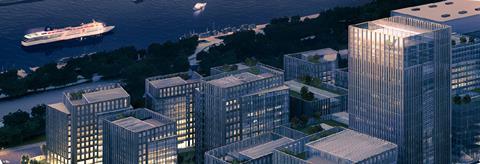Most businesses identify productivity growth as one of their biggest challenges. Helen Burch looks at ways that integrating technology into the design process can help your business become more efficient than ever before


Some 54% of the world’s population now live in urban areas, but the proportion is expected to increase to 66% by 2050. As people all over the world become increasingly urbanised, the construction industry faces huge challenges to work more efficiently than ever to provide development as space and resources are stretched.
All too often, projects run over time and over budget despite your best efforts to avoid this. Research shows 93% of building owners report projects as running late and 85% say projects exceed their agreed budget. Sometimes this is down to your clients requesting changes but, in many instances, inefficient workflows are to blame.
In an EIU survey, 74% of construction industry professionals said that their senior management team recognised productivity growth as a challenge, while 32% of construction professionals cited “poor communication and collaboration” as the single biggest hurdle to improving productivity.
Today’s design and engineering work requires multidisciplinary teams working together. But, with traditional design processes, you’re often left figuring out whether you have the latest updates to the design model or are waiting to collect the latest versions from other parties.
However, technology is creating new opportunities for us to transform the way we deliver projects to create maximum efficiency.
Imagine, your clients can stand in an unbuilt space and, with reality capture and augmented reality tools, visualise how their project will look in the context of the existing environment.
You could design buildings with exterior skins that automatically react to the sun and dynamically adjust throughout the day to manage light and heat gain, making them more sustainable and energy-efficient. And built-in sensors in gantries or signs could collect and analyse traffic data, making it easier for operators to respond proactively to congestion or accidents on the motorway.
Meanwhile, cloud computing creates opportunities to facilitate design iterations, analysis and better collaboration. Cloud-based services enable you to evaluate various design options more easily and choose alternatives that meet your most important design criteria.
The cloud helps teams distributed across distances collaborate more efficiently on models in real time.
The flow of new technologies is key to architects, engineering and construction companies as inefficiencies in workflow can have a direct impact on profit margins and the number of contracts won. The following five ‘inefficiency traps’ should be avoided to maximise productivity and profit.
Five design inefficiency traps derailing your success:
1. While 2D CAD has its place, you cannot completely rely on it for concept design or rapid prototyping. It makes exploring the full range of design options tricky, which can leave your projects feeling rather flat. With intelligent 3D modelling, you can quickly test the viability of different approaches early on in the design phase, resulting in a faster, more efficient workflow and designs that truly pop.
2. ��ɫ����TV or infrastructure projects only make sense when they come together, so why design them in isolation? With cloud-based 3D modelling, all project team members work on the same design in real time, so you can correct errors that may cost you dearly further down the line. Anywhere, anytime access lets you partner with global specialists and experiment with more collaborative delivery models.
3. Conventional topographic surveys take time, and inputting this data in design programs takes even longer. So you sometimes start your designs with a blank page even though there’s an existing canvas to fit into – leading to costly rework if you’ve failed to capture the existing structures correctly. You can avoid this by accurately capturing the existing terrain and structures upfront, and feeding this seamlessly into a model that reflects every dimension.
4. When 3D gaming and CGI movies are commonplace, 2D drawings can appear lacklustre and, for those outside the industry, downright confusing. With 3D renderings and interactive experiences, you can better show clients and the public your final designs, allowing them to engage with your vision. If someone makes a suggestion in a meeting, you can analyse revised models in real time to accelerate consensus and speed up the planning process.
5. Project delivery is no longer about engaging with the contractor at the end of the design phase. With data-rich 3D models, you can invite contractors to review your initial designs from a constructability perspective, ensuring they are viable from the earliest stages. You and your clients will benefit from higher-quality designs and fewer project overruns from rework, and your reputation will remain impeccable.
Learn how to break free from your inefficiency traps with a free eBook download from Autodesk: autode.sk/��ɫ����TVMag
![Move to bim listicle final[1][1]](https://d3sux4fmh2nu8u.cloudfront.net/Pictures/480xany/9/4/4/1840944_movetobim_listicle_final11_326162.jpg)




























No comments yet